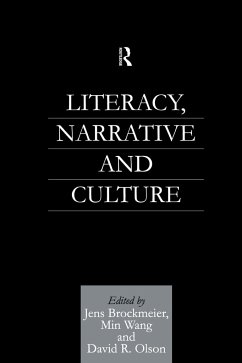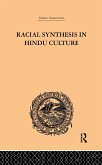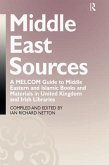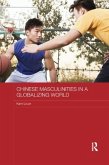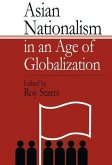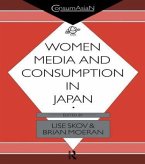Literacy, Narrative and Culture
Herausgeber: Brockmeier, Jens; Wang, Min; Olson, David R
Literacy, Narrative and Culture
Herausgeber: Brockmeier, Jens; Wang, Min; Olson, David R
- Broschiertes Buch
- Merkliste
- Auf die Merkliste
- Bewerten Bewerten
- Teilen
- Produkt teilen
- Produkterinnerung
- Produkterinnerung
Written language is closely related to other cultural practices such as narrative and painting. This book suggests that there is no theory or history of writing that does not presuppose a theory of culture and social development.
Andere Kunden interessierten sich auch für
![Lingua Franca in the Mediterranean Lingua Franca in the Mediterranean]() J. E. WansboroughLingua Franca in the Mediterranean40,99 €
J. E. WansboroughLingua Franca in the Mediterranean40,99 €![Racial Synthesis in Hindu Culture Racial Synthesis in Hindu Culture]() S V ViswanathaRacial Synthesis in Hindu Culture68,99 €
S V ViswanathaRacial Synthesis in Hindu Culture68,99 €![Middle East Sources Middle East Sources]() Ian Richard NettonMiddle East Sources48,99 €
Ian Richard NettonMiddle East Sources48,99 €![Chinese Masculinities in a Globalizing World Chinese Masculinities in a Globalizing World]() Kam LouieChinese Masculinities in a Globalizing World74,99 €
Kam LouieChinese Masculinities in a Globalizing World74,99 €![A Dictionary of Japanese Financial Terms A Dictionary of Japanese Financial Terms]() Dominic WilliamsA Dictionary of Japanese Financial Terms79,99 €
Dominic WilliamsA Dictionary of Japanese Financial Terms79,99 €![Asian Nationalism in an Age of Globalization Asian Nationalism in an Age of Globalization]() Roy StarrsAsian Nationalism in an Age of Globalization68,99 €
Roy StarrsAsian Nationalism in an Age of Globalization68,99 €![Women, Media & Consumption in Japan Women, Media & Consumption in Japan]() Brian MoeranWomen, Media & Consumption in Japan66,99 €
Brian MoeranWomen, Media & Consumption in Japan66,99 €-
-
-
Written language is closely related to other cultural practices such as narrative and painting. This book suggests that there is no theory or history of writing that does not presuppose a theory of culture and social development.
Hinweis: Dieser Artikel kann nur an eine deutsche Lieferadresse ausgeliefert werden.
Hinweis: Dieser Artikel kann nur an eine deutsche Lieferadresse ausgeliefert werden.
Produktdetails
- Produktdetails
- Verlag: Taylor & Francis Ltd (Sales)
- Seitenzahl: 332
- Erscheinungstermin: 19. Mai 2014
- Englisch
- Abmessung: 231mm x 155mm x 20mm
- Gewicht: 476g
- ISBN-13: 9780415760027
- ISBN-10: 041576002X
- Artikelnr.: 39699084
- Herstellerkennzeichnung
- Libri GmbH
- Europaallee 1
- 36244 Bad Hersfeld
- gpsr@libri.de
- Verlag: Taylor & Francis Ltd (Sales)
- Seitenzahl: 332
- Erscheinungstermin: 19. Mai 2014
- Englisch
- Abmessung: 231mm x 155mm x 20mm
- Gewicht: 476g
- ISBN-13: 9780415760027
- ISBN-10: 041576002X
- Artikelnr.: 39699084
- Herstellerkennzeichnung
- Libri GmbH
- Europaallee 1
- 36244 Bad Hersfeld
- gpsr@libri.de
Jens Brockmeier teaches at the Free University of Berlin. Since 1995 he has also been a Visiting Professor at the University of Toronto/OISE. He has published in the fields of psychology, philosophy, linguistics, and the history of culture. Min Wang has a post-doctoral fellowship from the Social Sciences and Humanities Research Council of Canada to work at the Learning Research and Development Center of the University of Pittsburgh. David R. Olson is University Professor at the University of Toronto/OISE. He is past-president of the Canadian Psychological Association and was co-director of the McLuhan Program in Culture and Technology at the University of Toronto. His research on cognition, language development, and literacy has resulted in numerous books.
1: Introduction: What is a culture of literacy?
Part I: Written culture
2: The literacy episteme: The rise and fall of a cultural discourse
3: Literacy and the future of writing: An integrational perspective
4: The construction of mind and self in an interpretive community 1 2
5: Hunting, tracking and reading
6: Narrative distancing: A foundation of literacy
Part II: The shaping of modern written culture
7: Letters and pictures in seventeenth-century education
8: Painters and literacy
9: "Dumb significants" and Early Modern English definition
10: The spread of culture: Subscription libraries in France in the nineteenth century
11: The essay as a literary and academic form: Closed gate or open door?
Part III: Literacy as cultural learning
12: Writing as a form of quotation
13: Children's conceptions of name: A study on metalinguistic awareness in Italian children
14: The distinction between graphic system and orthographic system and their pertinence for understanding the acquisition of orthography
15: Children's analysis of oral and written words
16: Young children's "clever misunderstandings" about print
17: Literacy and metalinguistic thought: Development through knowledge construction and cultural mediation
18: Making new or making do: Epistemological, normative and pragmatic aspects of reading a text
Part I: Written culture
2: The literacy episteme: The rise and fall of a cultural discourse
3: Literacy and the future of writing: An integrational perspective
4: The construction of mind and self in an interpretive community 1 2
5: Hunting, tracking and reading
6: Narrative distancing: A foundation of literacy
Part II: The shaping of modern written culture
7: Letters and pictures in seventeenth-century education
8: Painters and literacy
9: "Dumb significants" and Early Modern English definition
10: The spread of culture: Subscription libraries in France in the nineteenth century
11: The essay as a literary and academic form: Closed gate or open door?
Part III: Literacy as cultural learning
12: Writing as a form of quotation
13: Children's conceptions of name: A study on metalinguistic awareness in Italian children
14: The distinction between graphic system and orthographic system and their pertinence for understanding the acquisition of orthography
15: Children's analysis of oral and written words
16: Young children's "clever misunderstandings" about print
17: Literacy and metalinguistic thought: Development through knowledge construction and cultural mediation
18: Making new or making do: Epistemological, normative and pragmatic aspects of reading a text
1: Introduction: What is a culture of literacy?
Part I: Written culture
2: The literacy episteme: The rise and fall of a cultural discourse
3: Literacy and the future of writing: An integrational perspective
4: The construction of mind and self in an interpretive community 1 2
5: Hunting, tracking and reading
6: Narrative distancing: A foundation of literacy
Part II: The shaping of modern written culture
7: Letters and pictures in seventeenth-century education
8: Painters and literacy
9: "Dumb significants" and Early Modern English definition
10: The spread of culture: Subscription libraries in France in the nineteenth century
11: The essay as a literary and academic form: Closed gate or open door?
Part III: Literacy as cultural learning
12: Writing as a form of quotation
13: Children's conceptions of name: A study on metalinguistic awareness in Italian children
14: The distinction between graphic system and orthographic system and their pertinence for understanding the acquisition of orthography
15: Children's analysis of oral and written words
16: Young children's "clever misunderstandings" about print
17: Literacy and metalinguistic thought: Development through knowledge construction and cultural mediation
18: Making new or making do: Epistemological, normative and pragmatic aspects of reading a text
Part I: Written culture
2: The literacy episteme: The rise and fall of a cultural discourse
3: Literacy and the future of writing: An integrational perspective
4: The construction of mind and self in an interpretive community 1 2
5: Hunting, tracking and reading
6: Narrative distancing: A foundation of literacy
Part II: The shaping of modern written culture
7: Letters and pictures in seventeenth-century education
8: Painters and literacy
9: "Dumb significants" and Early Modern English definition
10: The spread of culture: Subscription libraries in France in the nineteenth century
11: The essay as a literary and academic form: Closed gate or open door?
Part III: Literacy as cultural learning
12: Writing as a form of quotation
13: Children's conceptions of name: A study on metalinguistic awareness in Italian children
14: The distinction between graphic system and orthographic system and their pertinence for understanding the acquisition of orthography
15: Children's analysis of oral and written words
16: Young children's "clever misunderstandings" about print
17: Literacy and metalinguistic thought: Development through knowledge construction and cultural mediation
18: Making new or making do: Epistemological, normative and pragmatic aspects of reading a text

